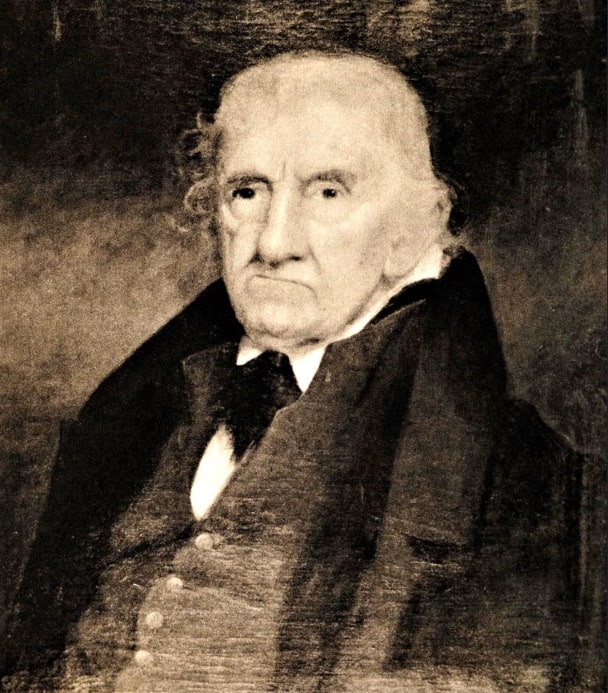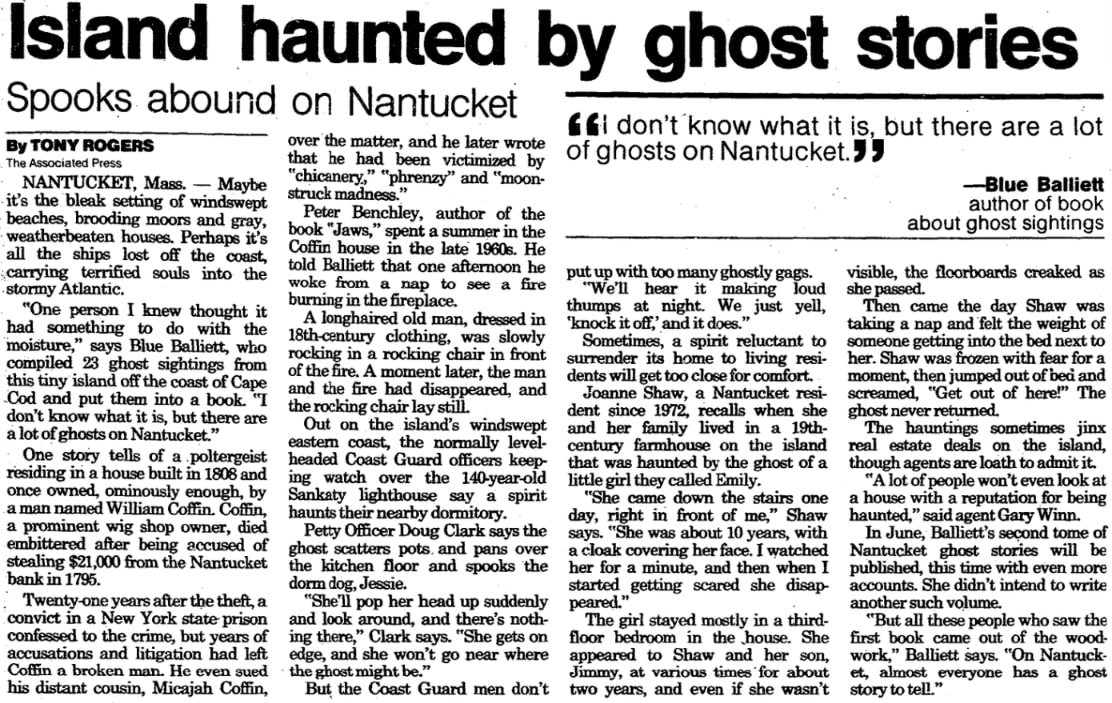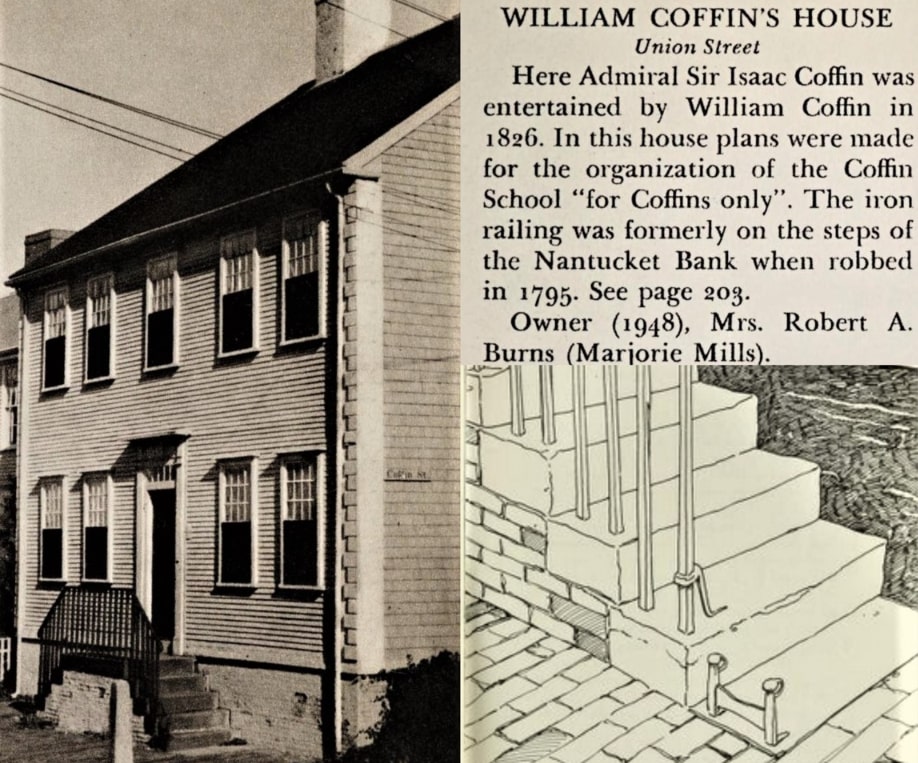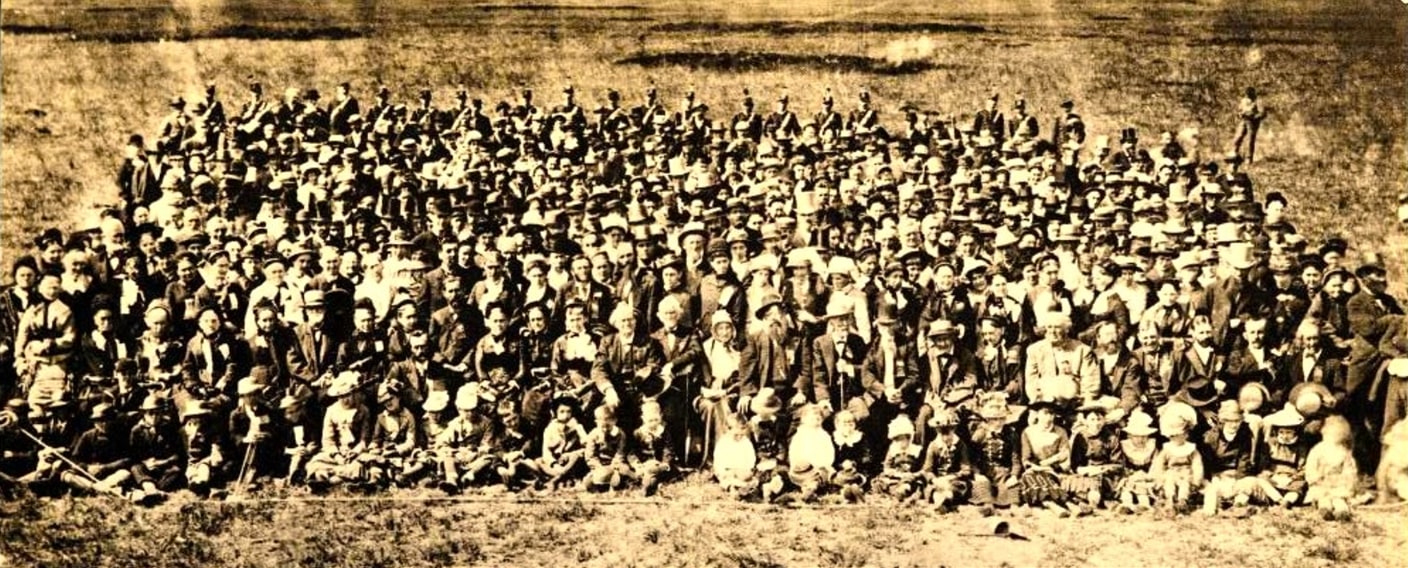Introduction: In this article, just in time for the approach of Halloween, Melissa Davenport Berry tells ghost stories from the island of Nantucket, Massachusetts. Melissa is a genealogist who has a blog, AnceStory Archives, and a Facebook group, New England Family Genealogy and History.
In 1990 newspapers across the country ran a story on the spook-filled island of Nantucket, Massachusetts. The tales of these haunting spirits were mainly sourced from Blue Balliett’s book “The Ghosts of Nantucket: 23 True Accounts.”
Among the phantoms Balliett writes about is William Coffin (1756-1835). (See lineage at the end of this article.)

The above portrait appeared in William Edward Gardner’s book “The Coffin Saga: Nantucket’s Story, from Settlement to Summer Visitors.” Gardner claimed that Coffin was:
“One of the most perplexing figures in Nantucket history. Deeds in the Registry record his progress: barber, peruke-maker, deputy post-master, appointed in Washington’s administration, trader, and merchant. He was fifty years old when he assaulted Micajah [Coffin] who was seventy-one.”
An article, “Island Haunted by Ghost Stories: Spooks Abound on Nantucket,” published in the Register Star newspaper, claimed that William Coffin, the shadow visitant, left this world embittered, and his disgruntled spirit roams the rooms of the house he once resided in.
Coffin was falsely accused and targeted as one of the prime suspects in the “Great Nantucket Bank Robbery” of 1795. It was America’s first bank heist and $21,000 in gold coins and paper (about $488,000 today) was stolen.
Although Coffin would not be found guilty of the theft, the ordeal left him bitter.

This article reported:
One story tells of a poltergeist residing in a house built in 1808 and once owned, ominously enough, by a man named William Coffin. Coffin, a prominent wig shop owner, died embittered after being accused of stealing $21,000 from the Nantucket bank in 1795.
Twenty-one years after the theft, a convict in a New York state prison confessed to the crime, but years of accusations and litigation had left Coffin a broken man. He even sued his distant cousin, Micajah Coffin, over the matter, and he later wrote that he had been victimized by “chicanery,” “phrenzy,” and “moonstruck madness.”

The owner of the Coffin house in 1948 (at the time of the above photo) was Mrs. Robert A. Burns, or Marjorie Mills, aka “Dame Boston,” a former columnist for the Boston Herald Traveler.
A clip from the same Rockford Register Star article tells another Nantucket ghost story:
Peter Benchley, author of the book “Jaws,” spent a summer in the Coffin house [rented from Marjorie Mills] in the late 1960s. He told Balliett that one afternoon he woke from a nap to see a fire burning in the fireplace.
A longhaired old man, dressed in 18th-century clothing, was slowly rocking in a rocking chair in front of the fire. A moment later, the man and the fire had disappeared, and the rocking chair lay still.
There is much more to the drama of the 1795 Nantucket bank robbery and the ghost of William Coffin. To know what really went down that foggy night and why it tore apart generations of family ties, stay tuned: all will be revealed in upcoming stories.
I found many different accounts from newspaper searches on GenealogyBank and various sources. Among them is William Edward Gardner, who made this claim:
“The island life [Nantucket] in the late seventeen hundreds was sadly affected by gossip and the gossip-lovers. Our ancestors had a thirst for news about people. The more successful or mysterious a person, the more his neighbors wanted to know about his daily life and business… Such persons, then as now, possessed active imaginations and did not get the highest satisfaction in telling the news unless there was some exaggeration. This is a primitive urge that is responsible for very great disasters. To get the full flavor of the mystery of the [1795] bank robbery, there must always be in the background of our minds certain undersurface forces that worked in our colonial life, and especially in an island town where isolation caused prejudices to be inflated, where suspicion became a kind of game indulged in for excitement.”

No doubt the older crowd attendees [at the 1881 family reunion] engaged in gossip, and their descendants would inherit the echoes of the scandalous narrative of the “malevolent” William Coffin and the Great Nantucket Bank Robbery of 1795!
Stay tuned!
Lineage:
- William Coffin II (1756-1835) married Deborah Pinkham, daughter of Jonathan Pinkham and Jemima Swain
- William Coffin and Jedidah Folger
- Francis Coffin and Theodate Gorham, daughter of Shubael Gorham and Puella Hussey, granddaughter of John Gorham and Desire Howland, daughter of Mayflower passengers John Howland and Elizabeth Tilley
- John Coffin and Hope Gardner, daughter of Richard Gardner and Sarah Shattuck; both descend from the Salem, Massachusetts, Quaker families
- James Coffin and Mary Severance
- Tristram and Dionis Coffin
Explore over 330 years of newspapers and historical records in GenealogyBank. Discover your family story! Start a 7-Day Free Trial
Note on the header image: 1870s Nantucket street scene by C. H. Shute & Son of Edgartown, Massachusetts. Credit: Wikimedia Commons.
